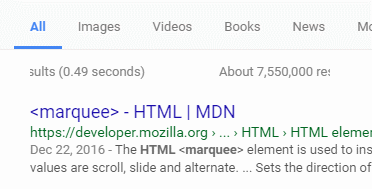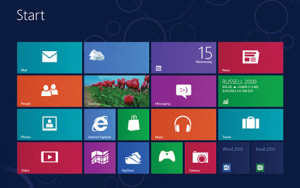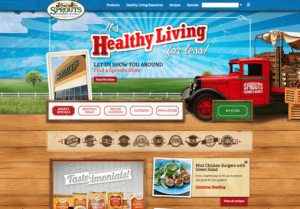After looking at the top 10 future website trends for 2019 (blog post coming), it made me pause and consider the question “How long DO digital website design trends have a shelf life?” Some trends tend to be either driven by a new type of code that’s available. Or it’s just personal meme/gestalt-like preferences that indicates times have changed. Think bell bottom jeans of the 70’s and parachute pants of the 80’s. Fashion has a clear calendar and cadence of change dictated by the fashion industry – Spring, Fall, etc. And it’s been happening for thousands of years. But digital trends tend to rely on both the technology available (Photoshop comes out with a new layer effect YAY) AND evolving personal preferences.
Top 10 past digital design trends that have come and gone:
 1. Glossy Buttons (early 2000’s) – I remember when Photoshop came out with nifty layer effects that would automatically created beveled, embossed, glossy, buttons with a cool drop shadow effect. There is nothing that screams late 90’s/early 2000’s. SHELF LIFE UNFORTUNATELY = 5 years
1. Glossy Buttons (early 2000’s) – I remember when Photoshop came out with nifty layer effects that would automatically created beveled, embossed, glossy, buttons with a cool drop shadow effect. There is nothing that screams late 90’s/early 2000’s. SHELF LIFE UNFORTUNATELY = 5 years
2. Blink Tag (1995)- believe it or not, some browsers still have this tag in it’s markup. But it WAS the first way to animate text in the early 90’s. SHELF LIFE = 5 years

3. News Tickers (early 2000’s)- again, an early way to animate text that may have also pulled the UI idea from the equally annoying TV news tickers running across the bottom of the screen. SHELF LIFE = 3 years
4. Auto-play Music or Video (1996-early 2000’s)- used to scare the crap out of me when a website would start on it’s own to play music or video with sound. And invariably, my volume on my computer was set to WAAAY loud. SHELF LIFE=4 years
5. I-frames (1995-early 2000’s)- yes, I’m embarrassed to say I’ve used I-frames many times in my career. Again, it was a technology devise to be able to create intricate layouts or pull content in from another source. SHELF LIFE=5 years
 7. Web 2.0 Flat Design (2012-now) – with the introduction of another new technology of mobile in the mid 2000’s, a more restrained design was utilized that killed all those glossy drop shadow mega-goop designers were using. And Microsoft’s Metro design was considered innovative and new utilizing this flat grid dashboard design. SHELF LIFE=7 years
7. Web 2.0 Flat Design (2012-now) – with the introduction of another new technology of mobile in the mid 2000’s, a more restrained design was utilized that killed all those glossy drop shadow mega-goop designers were using. And Microsoft’s Metro design was considered innovative and new utilizing this flat grid dashboard design. SHELF LIFE=7 years
6. Flash Intros, Skip Intro (early 2000’s-2015) – Started because of the launch of HTML5, Flash was the coolest, most exciting trend in the early 2000’s. This is one of my pet peeves about early flash sites as the user was forced to sit through a launching screen in order to see the website. Luckily some great UI person suggested we add a very small “Skip Intro” text link, which ended-up being the most clicked on item on the internet. Big shout-out to Steve Jobs for  killing flash. Thank you man. SHELF LIFE=5 years
killing flash. Thank you man. SHELF LIFE=5 years
8. Realistic Design (2010-2012)- the introduction to expansive photo stock houses, there were complete availability to photo backgrounds of tiles, wood, cool walls, etc. And in suite, there were many websites that adopted a more realistic interface utilizing many cool backgrounds and photo realistic web elements. I personally use this photo realistic design trend on MANY DVD menus I created for Disney in the 2000’s. SHELF LIFE=2 years.
 9. Overly Metaphoric Stock Photography (early 2000’s) – again the introduction of super affordable stock photo houses (think iStockPhoto), somehow there became a glut of the same photos used over and over again on the web. The worst offender in my book was the ubiquitous shaking hands. SHELF LIFE=3 long years
9. Overly Metaphoric Stock Photography (early 2000’s) – again the introduction of super affordable stock photo houses (think iStockPhoto), somehow there became a glut of the same photos used over and over again on the web. The worst offender in my book was the ubiquitous shaking hands. SHELF LIFE=3 long years
10. Parallax Long Scroll-y Pages (2014-now) – This technology allows for designers to carefully craft how content and graphics are automatically layered into the browser as the user scrolls down the page. This precludes  having to wait for pages to preload making it in theory a more efficient browsing experience. But there are a multitude of usability issues as the user loses their attention and potentially bounces. Someone decided creating a vertical bar navigation showing what’s below the fold would solve the problem. Well that trend lasted just a year. But we’re still seeing very long pages.
having to wait for pages to preload making it in theory a more efficient browsing experience. But there are a multitude of usability issues as the user loses their attention and potentially bounces. Someone decided creating a vertical bar navigation showing what’s below the fold would solve the problem. Well that trend lasted just a year. But we’re still seeing very long pages.